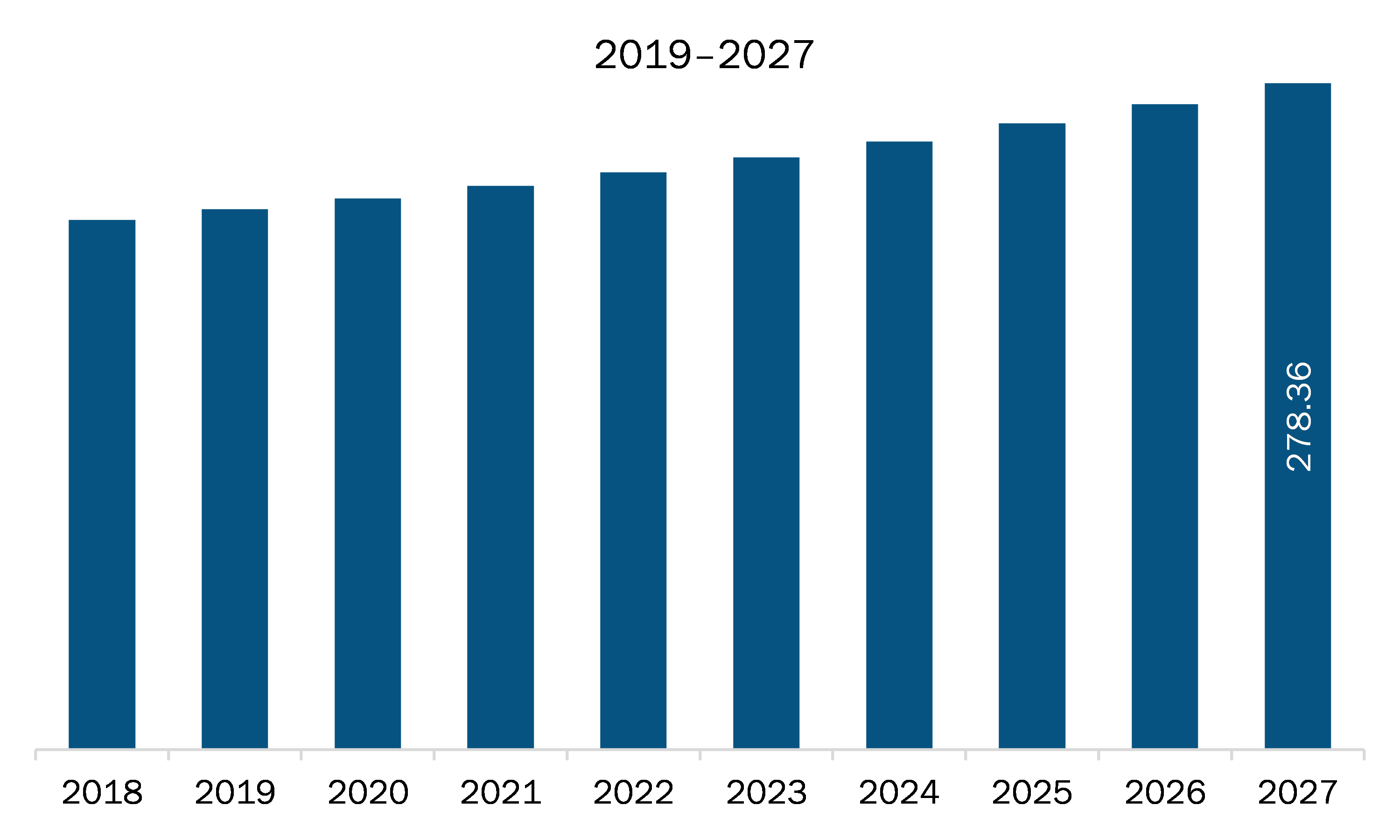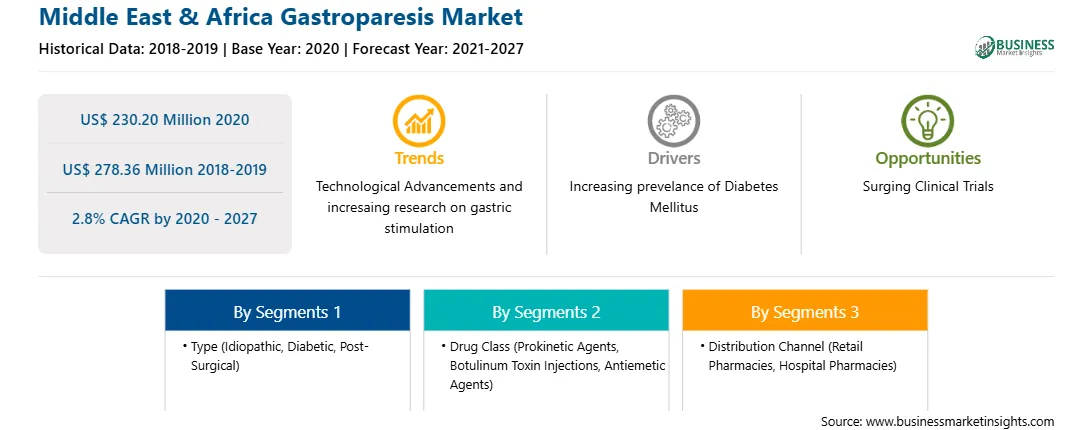MEA consists of three major countries namely United Arab Emirates (UAE), Saudi Arabia and South Africa. Saudi Arabia is the largest market for gastroparesis. The market is driven by extensive research projects undertaken by a number of research institutes, rising prevalence of gastroparesis, and availability of infrastructure and facilities for research in UAE and Saudi Arabia. Rest of MEA include countries such as, Israel, Iran, Iraq, Kuwait, Oman, Egypt, Kenya, and others. Rising focus of development of innovative therapies for the treatment of gastrointestinal diseases across the region is expected to offer a lucrative opportunity for the growth of the market. Moreover, the government in the region are actively investing in the research and development in collaboration with international players to boost drug discovery for gastroparesis in the region. Such strategic steps by the government authorities are estimated to drive the growth of rest of MEA gastroparesis market during the forecast period.
The COVID-19 has shown substantial effects in MEA. The COVID-19 pandemic has caused massive disruptions to global supply chains and affected the research and development activities in these countries in 2020. The companies are preferring non-physical marketing campaigns and shifting sales processes online. The COVID-19 has affected the sales of essential OTC drugs such as anti-emetic and prokinetic drugs. Moreover, the exports and imports of pharmaceutical products are returning to their original momentum. Thus, the availability of the products in the region is improving. Therefore, the growth in African pharmaceuticals is likely to boost the development of the anti-emetic drugs in market. For instance, in May 2020, the Vice president of global health stated in a blog post of Africa program, “The African Medicines Agency (AMA), a continental effort to harmonize medicines regulation, should be fully approved and rapidly scaled up to advance regulatory dependence, mutual recognition, and risk-based regulatory practices. The AMA will also help and support in the production of active ingredients in Africa, streamline market access, and reduce barriers to market entry for manufacturers.

Strategic insights for the Middle East & Africa Gastroparesis provides data-driven analysis of the industry landscape, including current trends, key players, and regional nuances. These insights offer actionable recommendations, enabling readers to differentiate themselves from competitors by identifying untapped segments or developing unique value propositions. Leveraging data analytics, these insights help industry players anticipate the market shifts, whether investors, manufacturers, or other stakeholders. A future-oriented perspective is essential, helping stakeholders anticipate market shifts and position themselves for long-term success in this dynamic region. Ultimately, effective strategic insights empower readers to make informed decisions that drive profitability and achieve their business objectives within the market.

| Report Attribute | Details |
|---|---|
| Market size in 2020 | US$ 230.20 Million |
| Market Size by 2027 | US$ 278.36 Million |
| Global CAGR (2020 - 2027) | 2.8% |
| Historical Data | 2018-2019 |
| Forecast period | 2021-2027 |
| Segments Covered |
By Type
|
| Regions and Countries Covered | Middle East and Africa
|
| Market leaders and key company profiles |
The geographic scope of the Middle East & Africa Gastroparesis refers to the specific areas in which a business operates and competes. Understanding local distinctions, such as diverse consumer preferences (e.g., demand for specific plug types or battery backup durations), varying economic conditions, and regulatory environments, is crucial for tailoring strategies to specific markets. Businesses can expand their reach by identifying underserved areas or adapting their offerings to meet local demands. A clear market focus allows for more effective resource allocation, targeted marketing campaigns, and better positioning against local competitors, ultimately driving growth in those targeted areas.

The gastroparesis market in MEA is expected to grow from US$ 230.20 million in 2020 to US$ 278.36 million by 2027; it is estimated to grow at a CAGR of 2.8% from 2020 to 2027. Gastric emptying is associated with the coordination among the motor activity of proximal stomach, distal stomach, and duodenum. These internal organs are controlled by the feedback mechanism from neural signals generated through the interaction between nutrients and small intestine. Aging leads to diminished homeostatic regulations of physiologic functions, along with the slowing of gastric emptying. Moreover, it influences motor and sensory functions. In addition, geriatric population is highly vulnerable to gastroparesis due to factors such as the poor oral medication absorption, inadequate appetite regulation, and postprandial glycemia. According to the 2019 revision of World Population Prospects, 1 in 6 people would be aged more than 65 by 2050, with an increase from 1 in 11 in 2019. Thus, the continuous increase in aging population and issues associated with gastric emptying among the elderly population drive the gastroparesis market.
The MEA gastroparesis market is segmented on the basis of type, drug class, distribution channel, and country. The MEA gastroparesis market, by type, is segmented into idiopathic, diabetic, post-surgical, and others. The idiopathic segment held the largest share of the market in 2019. The MEA gastroparesis market, by drug class type, is segmented into prokinetic agents, botulinum toxin injection, and antiemetic agents. The prokinetic agents segment held the largest share of the market in 2019. Based on distribution channel, the MEA gastroparesis market is segmented into retail pharmacies, hospital pharmacies, and others. The hospital pharmacies segment held the largest share of the market in 2019. Based on country, the MEA gastroparesis market is segmented into Saudi Arabia, South Africa, UAE, and rest of MEA. Saudi Arabia held the largest market share in 2019.
A few major primary and secondary sources referred to for preparing this report on the gastroparesis market in MEA are company websites, annual reports, financial reports, national government documents, and statistical database, among others. Major companies listed in the report are Allergan Plc; Bausch Health Companies Inc. (Salix Pharmaceuticals, Ltd.); Ipca Laboratories Ltd.; Johnson and Johnson Services, Inc.; Pfizer Inc.; and TEVA PHARMACEUTICAL INDUSTRIES LTD.
The Middle East & Africa Gastroparesis Market is valued at US$ 230.20 Million in 2020, it is projected to reach US$ 278.36 Million by 2027.
As per our report Middle East & Africa Gastroparesis Market, the market size is valued at US$ 230.20 Million in 2020, projecting it to reach US$ 278.36 Million by 2027. This translates to a CAGR of approximately 2.8% during the forecast period.
The Middle East & Africa Gastroparesis Market report typically cover these key segments-
The historic period, base year, and forecast period can vary slightly depending on the specific market research report. However, for the Middle East & Africa Gastroparesis Market report:
The Middle East & Africa Gastroparesis Market is populated by several key players, each contributing to its growth and innovation. Some of the major players include:
The Middle East & Africa Gastroparesis Market report is valuable for diverse stakeholders, including:
Essentially, anyone involved in or considering involvement in the Middle East & Africa Gastroparesis Market value chain can benefit from the information contained in a comprehensive market report.